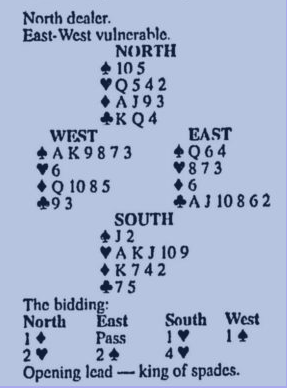Reading Eagle – 14 Oct 2002
There are times when declarer must conduct an investigation of the opposing distribution in order to give himself the best chance for the contract. Consider this case where South reaches four hearts on the bidding shown.

West begins by cashing the K-A of spades and shifts to the nine of clubs. Dummy’s queen loses to East’s ace, and the jack of clubs return is taken by dummy’s king. South has lost the first three tricks and must now avoid losing a diamond to make the contract. Before tackling the diamonds, however, he should do all he possibly can to find out how the unseen cards in the various suits are divided.
Declarer starts by drawing three rounds of trumps, ending in dummy. He then makes the crucial play of ruffing the four of clubs, on which West discards a spade. The count of the hand is now complete, and South should know exactly how to play the diamonds without losing a trick in the suit.
Accordingly, he cashes the king of diamonds, then leads a diamond and finesses the nine. After the nine holds, he returns to his hand with a trump and finesses the jack of diamonds to make the contract. The reason South can confidently take the initial deep finesse in diamonds is based on simple arithmetic.
As the play progressed, he learned that East had started with three hearts and six clubs (because West had shown up with a singleton heart and a doubleton club). South could also tell from the bidding that East had started with either three or four spades.
With at least 12 of East’s cards in three suits thus accounted for, it followed that East could not have been dealt more than one diamond. Therefore, finessing the nine and then the jack was sure to succeed.
